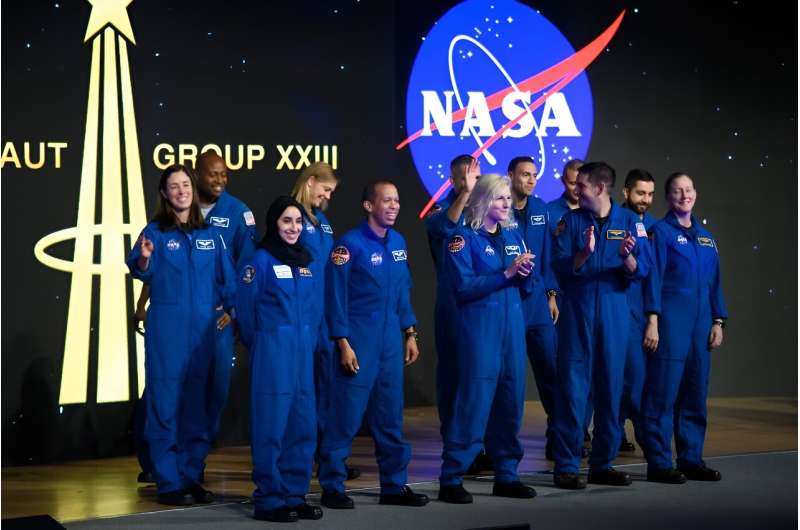Agile Space wins contract for deployable satellite processing unit
Tuesday, 05 March 2024 19:48

New NASA astronauts graduate, eying moon—and Mars
Tuesday, 05 March 2024 19:41
After two years of rigorous training, ten Americans officially became astronauts on Tuesday, and are now eligible for planned NASA missions to the International Space Station, the moon, and—if all goes well—to Mars.
Two Emiratis who trained alongside them also graduated Tuesday during a ceremony at the Johnson Space Center in Houston.
Members of the class, nicknamed "The Flies," were selected from more than 12,000 applicants in 2021 and their training included simulated spacewalking, robotics, space station systems, and more.
"You are here because you are exceptional," said NASA associate administrator Jim Free. We ask you to sit on the pointy end of a rocket and risk your life to advance our nation's goal to explore the unknown.
U.S. general warns of Russia’s enduring space threat despite Ukraine woes
Tuesday, 05 March 2024 17:47

Astronauts arrive at International Space Station for swap
Tuesday, 05 March 2024 17:20
Three US astronauts and a Russian cosmonaut arrived Tuesday at the International Space Station for a six-month mission on board the orbiting laboratory.
During their stay, in which they are rotating in to replace departing crew, some 200 scientific experiments are scheduled to be carried out.
The quartet blasted off from Florida late Sunday aboard a SpaceX Falcon 9 rocket.
The capsule docked with the ISS and its hatch was opened at 3:50 am Tuesday US eastern time (0850 GMT), with the smiling new arrivals hugging their colleagues as they entered, a live feed of the docking showed.
This is the eighth standard ISS crew rotation mission performed by SpaceX for the US space agency NASA, reflected in the mission name: Crew-8.
American Michael Barratt is the only Crew-8 astronaut to have already visited the space station. The ISS stay is the first for Americans Matthew Dominick and Jeanette Epps, and Russian Alexander Grebenkin.
They join seven crew already on board the ISS.
After a transition period of a few days, the four members of Crew-7—from Denmark, Japan, Russia and the United States—will return to Earth aboard another SpaceX capsule.
Study determines the original orientations of rocks drilled on Mars
Tuesday, 05 March 2024 17:13 As it trundles around an ancient lakebed on Mars, NASA's Perseverance rover is assembling a one-of-a-kind rock collection. The car-sized explorer is methodically drilling into the Red Planet's surface and pulling out cores of bedrock that it's storing in sturdy titanium tubes. Scientists hope to one day return the tubes to Earth and analyze their contents for traces of embedded microbial life.
As it trundles around an ancient lakebed on Mars, NASA's Perseverance rover is assembling a one-of-a-kind rock collection. The car-sized explorer is methodically drilling into the Red Planet's surface and pulling out cores of bedrock that it's storing in sturdy titanium tubes. Scientists hope to one day return the tubes to Earth and analyze their contents for traces of embedded microbial life. NASA Names Winners in Lunar Gateway Packing and Storing Challenge
Tuesday, 05 March 2024 17:13 Humans living in space have confronted the challenge of maximizing the physical space available to them. As NASA works to return astronauts to the Moon with its Artemis campaign and chart a new era of deep space exploration with Gateway, humanity's first space station in lunar orbit, being organized and space-efficient is important.
To help address the iss
Humans living in space have confronted the challenge of maximizing the physical space available to them. As NASA works to return astronauts to the Moon with its Artemis campaign and chart a new era of deep space exploration with Gateway, humanity's first space station in lunar orbit, being organized and space-efficient is important.
To help address the iss ispace Europe and CDS Partner to Deploy Advanced Localization Tech on the Moon
Tuesday, 05 March 2024 17:13 ispace EUROPE S.A., a Luxembourg-based subsidiary of ispace, inc., has entered into a strategic memorandum of understanding with Control Data Systems SRL (CDS). This collaboration is aimed at developing localization and telecommunications technology to for Lunar applications in support of the quest for sustainable human presence and infrastructure development on Earth's natural satellite.
ispace EUROPE S.A., a Luxembourg-based subsidiary of ispace, inc., has entered into a strategic memorandum of understanding with Control Data Systems SRL (CDS). This collaboration is aimed at developing localization and telecommunications technology to for Lunar applications in support of the quest for sustainable human presence and infrastructure development on Earth's natural satellite. NASA uses ORNL supercomputers to plan smooth landing on Mars
Tuesday, 05 March 2024 17:13 A U.S. mission to land astronauts on the surface of Mars will be unlike any other extraterrestrial landing ever undertaken by NASA.
Although the space agency has successfully landed nine robotic missions on Mars since its first surface missions in 1976 with the Viking Project, safely bringing humans to Mars will require new technologies for flight through the Martian atmosphere. But these
A U.S. mission to land astronauts on the surface of Mars will be unlike any other extraterrestrial landing ever undertaken by NASA.
Although the space agency has successfully landed nine robotic missions on Mars since its first surface missions in 1976 with the Viking Project, safely bringing humans to Mars will require new technologies for flight through the Martian atmosphere. But these Curiosity successfully drills 40 holes on Mars
Tuesday, 05 March 2024 17:13 Earth planning date: Friday, March 1, 2024: The "Mineral King" drill hole did not quite reach the target depth that we typically desire to ensure that we have enough sample in the drill stem to deliver to our internal CheMin and SAM instruments.
However, based on the information we did have (see details in the Sol 4110 blog), we proceeded with delivery to CheMin, and got the good news yest
Earth planning date: Friday, March 1, 2024: The "Mineral King" drill hole did not quite reach the target depth that we typically desire to ensure that we have enough sample in the drill stem to deliver to our internal CheMin and SAM instruments.
However, based on the information we did have (see details in the Sol 4110 blog), we proceeded with delivery to CheMin, and got the good news yest NASA's Juno Mission Measures Oxygen Production at Europa
Tuesday, 05 March 2024 17:13 Scientists with NASA's Juno mission to Jupiter have calculated the rate of oxygen being produced at the Jovian moon Europa to be substantially less than most previous studies. Published on March 4 in Nature Astronomy, the findings were derived by measuring hydrogen outgassing from the icy moon's surface using data collected by the spacecraft's Jovian Auroral Distributions Experiment (JADE) instr
Scientists with NASA's Juno mission to Jupiter have calculated the rate of oxygen being produced at the Jovian moon Europa to be substantially less than most previous studies. Published on March 4 in Nature Astronomy, the findings were derived by measuring hydrogen outgassing from the icy moon's surface using data collected by the spacecraft's Jovian Auroral Distributions Experiment (JADE) instr Solved at Pitt: What are Saturn's rings made of?
Tuesday, 05 March 2024 17:13 On a given night, the Allegheny Observatory might be hosting an open house, a lecture given by astronomy experts, educational programs for kids or tours set aside specifically for teachers and their families.
Most nights of the week, Pitt students are also at the observatory, hard at work learning how to use the tools of astronomy to explore the night sky and understand the rules that gove
On a given night, the Allegheny Observatory might be hosting an open house, a lecture given by astronomy experts, educational programs for kids or tours set aside specifically for teachers and their families.
Most nights of the week, Pitt students are also at the observatory, hard at work learning how to use the tools of astronomy to explore the night sky and understand the rules that gove PYXIS satellite set to enhance satellite technology
Tuesday, 05 March 2024 17:13 Axelspace Corporation, a Tokyo-based leader in the microsatellite sector, has announced the scheduled launch of its latest demonstration satellite, PYXIS. The launch is set to take place on March 4, 2024, utilizing SpaceX's reliable Falcon 9 rocket from Vandenberg Space Force Base in California, USA. This mission, dubbed Transporter-10, aims to place PYXIS into a sun-synchronous orbit between 50
Axelspace Corporation, a Tokyo-based leader in the microsatellite sector, has announced the scheduled launch of its latest demonstration satellite, PYXIS. The launch is set to take place on March 4, 2024, utilizing SpaceX's reliable Falcon 9 rocket from Vandenberg Space Force Base in California, USA. This mission, dubbed Transporter-10, aims to place PYXIS into a sun-synchronous orbit between 50 JWST images dispersing gas in a planet-forming disk for first time
Tuesday, 05 March 2024 17:13 An international team of astronomers, led by Naman Bajaj from the University of Arizona, has utilized the unparalleled capabilities of the James Webb Space Telescope (JWST) to provide new insights into the final stages of planet formation. This marks the first time scientists have imaged winds emanating from an aging, yet still planet-forming, disk around the young star TCha, offering a rare gli
An international team of astronomers, led by Naman Bajaj from the University of Arizona, has utilized the unparalleled capabilities of the James Webb Space Telescope (JWST) to provide new insights into the final stages of planet formation. This marks the first time scientists have imaged winds emanating from an aging, yet still planet-forming, disk around the young star TCha, offering a rare gli Bayesian network analysis sheds light on sci-fi and real-world exoplanet representation
Tuesday, 05 March 2024 17:13 A team from the St Andrews Centre for Exoplanet Science and the Space Research Institute (IWF) of the Austrian Academy of Sciences has utilized Bayesian network analysis to quantitatively examine the portrayal of exoplanets in science fiction. This research marks a significant step forward in understanding the relationship between scientific discovery and its representation in popular culture, p
A team from the St Andrews Centre for Exoplanet Science and the Space Research Institute (IWF) of the Austrian Academy of Sciences has utilized Bayesian network analysis to quantitatively examine the portrayal of exoplanets in science fiction. This research marks a significant step forward in understanding the relationship between scientific discovery and its representation in popular culture, p Multiple Spacecraft Tell the Story of One Giant Solar Storm
Tuesday, 05 March 2024 17:13 April 17, 2021, was a day like any other day on the Sun, until a brilliant flash erupted and an enormous cloud of solar material billowed away from our star. Such outbursts from the Sun are not unusual, but this one was unusually widespread, hurling high-speed protons and electrons at velocities nearing the speed of light and striking several spacecraft across the inner solar system.
In fa
April 17, 2021, was a day like any other day on the Sun, until a brilliant flash erupted and an enormous cloud of solar material billowed away from our star. Such outbursts from the Sun are not unusual, but this one was unusually widespread, hurling high-speed protons and electrons at velocities nearing the speed of light and striking several spacecraft across the inner solar system.
In fa 
